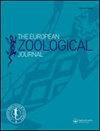高加索生态区的水虫(异翅目:Gerromorpha,Nepomorpha)
IF 1.6
4区 生物学
Q2 ZOOLOGY
引用次数: 1
摘要
摘要根据文献调查、博物馆和私人收藏以及广泛的野外采样数据,对高加索水虫动物群(异翅目:Gerromorpha,Nepomorpha)进行了综述。高加索生态区的多样性非常显著,共有77个物种和亚种,分布在25个属(Nepomorpha 17个,Gerromorpha 8个)和13个科(Nepomorpha 8,Gerromoromorpha 5个)内。anatolica Micronecta anatolica Lindberg,1922年,Sigara iranica Lindberg,1964年,S.samani tigranes Jansson,1986年,Velia kirithenkoi Tamanini,1958年和Gerris asper(Fieber,1860)首次从格鲁吉亚报道,M.anatolica anatolica,Notonecta maculata Fabricius,1794年,Mesovelia thermalis Horváth,1915年,和Gerris lacustris(Linnaeus,1758)代表了亚美尼亚的新记录,和Microvelia macani Brown,1953年是新的阿塞拜疆。一项合唱和相似性分析强调了与邻国之间的联系,高加索生态区与土耳其的水虫动物群相似性最高,而伊朗和俄罗斯(欧洲领土)最低。共有物种/亚种的数量最多的是高加索和土耳其(64个分类群),而最少的是伊朗和俄罗斯(40个分类群。我们的研究结果表明,高加索地区代表了不同起源的各种动物区系元素的复合体,从高加索特有种到非洲-地中海-地中海和全北极。本文章由计算机程序翻译,如有差异,请以英文原文为准。
Water bugs (Heteroptera: Gerromorpha, Nepomorpha) of the Caucasus ecoregion
Abstract The Caucasian fauna of water bugs (Heteroptera: Gerromorpha, Nepomorpha) is reviewed based on data originating from literature survey, museum and private collections, and extensive field sampling. The diversity of Caucasus ecoregion is quite significant with 77 species and subspecies framed within 25 genera (17 in Nepomorpha, 8 in Gerromorpha), and 13 families (8 in Nepomorpha, 5 in Gerromorpha). Micronecta anatolica anatolica Lindberg, 1922, Sigara iranica Lindberg, 1964, S. samani tigranes Jansson, 1986, Velia kiritshenkoi Tamanini, 1958, and Gerris asper (Fieber, 1860) are reported for the first time from Georgia, M. anatolica anatolica, Notonecta maculata Fabricius, 1794, Mesovelia thermalis Horváth, 1915, and Gerris lacustris (Linnaeus, 1758) represent new records for Armenia, and Microvelia macani Brown, 1953 is new for Azerbaijan. A chorological and similarity analysis highlighted the connections with and between adjacent countries, with Caucasus ecoregion having the highest similarity of the water bug fauna with Turkey, whereas Iran and Russia (European territory) have the lowest. The largest number of shared species/subspecies was found between the Caucasus and Turkey (64 taxa), while the lowest was between Iran and Russia (40 taxa). Our results indicate that the Caucasus represents a composite of various faunal elements of different origin, ranging from Caucasian endemics to Afrotropico-Indo-Mediterranean and Holarctic.
求助全文
通过发布文献求助,成功后即可免费获取论文全文。
去求助
来源期刊

European Zoological Journal
Agricultural and Biological Sciences-Animal Science and Zoology
CiteScore
3.10
自引率
5.60%
发文量
80
审稿时长
30 weeks
期刊介绍:
The European Zoological Journal (previously Italian Journal of Zoology) is an open access journal devoted to the study of all aspects of basic, comparative and applied protozoan and animal biology at molecular, cellular, tissue, organ, organismal, population, and community-ecosystem level. Papers covering multiple levels of organization and integrative approaches to study animal form, function, development, ecology, evolution and systematics are welcome. First established in 1930 under the name of Il Bollettino di Zoologia, the journal now has an international focus, reflected through its global editorial board, and wide author and readership.
 求助内容:
求助内容: 应助结果提醒方式:
应助结果提醒方式:


